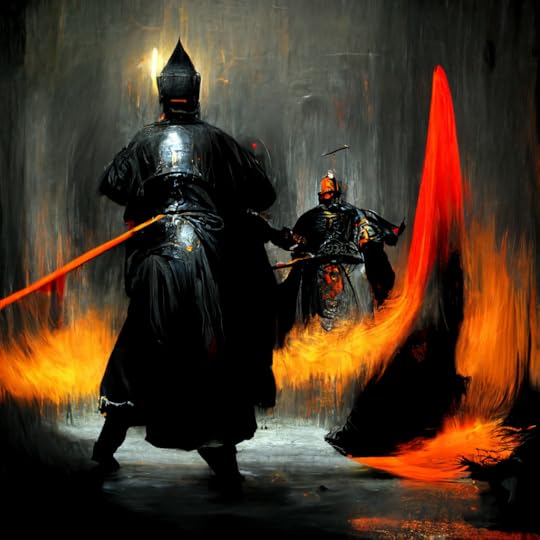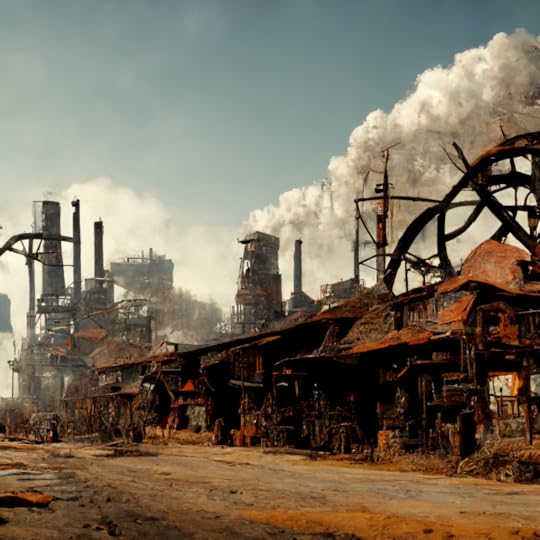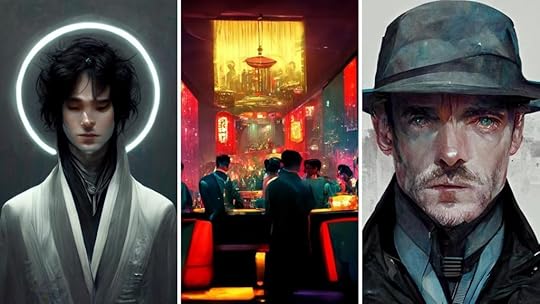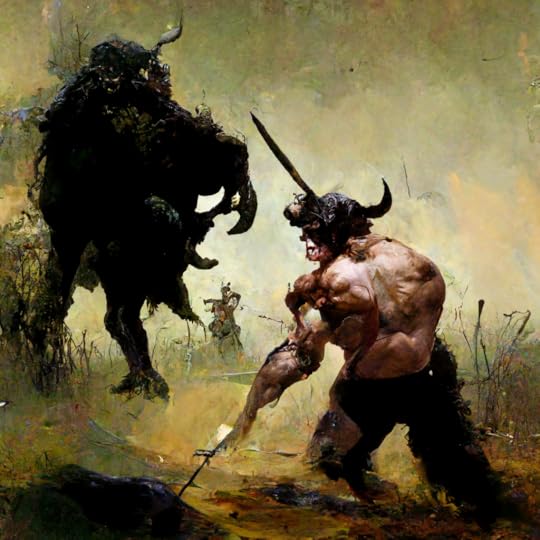Midjourney AI Art: Destroyer of Worlds?
I’ve been experimenting with Midjourney for a few weeks now, so it’s time to write about the experience. First of all, I’m well aware of the controversy surrounding AI art generators, as I’m acquainted with more than a few artists, most of who despise their very existence. And I get it; we’re talking about livelihoods being threatened. Every person who turns to an art generator for a project is potentially a customer who might have used a human artist instead. So, if you’re income is dependent on commissioned work, you’d be alarmed at the very least at the idea of losing bids to a soulless machine. I certainly don’t want to be insensitive to those concerns because there’s a very valid discussion about usage rights, intellectual properties, copyrights, etc. It’s a Wild West atmosphere with AI art right now, reminiscent of the start of the cryptocurrency boom. Will AI art end up on the same roller coaster ride of extreme highs and lows? Only time will tell.
But make no mistake: AI generators are here to stay. The dam has burst, and there’s no way to stop the torrent now. I personally believe that artists are less threatened than they imagine because there will always be those things that can’t be generated randomly or by carefully written prompts. What separates digital from human are the intangibles, the things not easily expressed but understood because, well … that’s what makes us human.
But returning to the subject: Midjourney. It’s been my favorite of the various apps and programs I’ve tried, other than Artbreeder, which is much more limited. (I’ll probably do a blog on Artbreeder later.) How does Midjourney work? Keeping it simple, you type in a prompt, and it produces art accordingly. Example:
Evil knight in black armor fighting monk in robes with glowing swords and fiery background
And the result:
 ‘Tis a flesh wound.
‘Tis a flesh wound.Yeah, not too impressive. I didn’t think much of it, as several other attempts resulted in even worse results: ugly features, nightmare eyes, clunky results. I nearly gave up entirely, but I knew the program had to be solid because other people were producing art that looked way better than I was getting. So, I did what artists and writers have done since art existed: look at what someone else did and steal it. Which, ironically, is what the whole uproar over AI art is about. But anyway, what I mean is look at other people’s prompts, copy them, and adjust according to my needs, kind of like writing HTML code back in the day. So, I went from drab, ugly results to being able to generate something that actually looked pretty cool. Midjourney works best when pointed to a style to imitate, such as Unreal Engine. Case in point:
Dystopian town, old Western, dusty and rusty, ancient steel mill in center, style of unreal engine
And the result:
 Almost looks good
Almost looks goodNow, I was on to something. But to get even better results, the key is detailed prompts, then using the Version and Upscale options to keep tweaking and chiseling down the results until you get the best version. Granted, it can get tedious, but I have no complaints. I mean, look at what can happen when you get your prompts right. Here is a trio of my latest results:

The results are literally limitless once you get the hang of it. Of course, the above results were achieved with prompt changes, upscaling, and version spawning. But the results speak for themselves. In a few weeks, I’ve generated three hundred twenty-five jobs at the time of this writing. I’m not sure if MJ counts each image as a job, or each prompt, because I didn’t bother to count all the images I’ve generated. It’s a lot. But the value as a tool for concept creation is priceless. I can literally generate anything in my imagination, so long as I can write the proper prompts and tweak the results.
And therein lies the threat to the artist community.
So, let’s crack this down. Let’s say I want to create a slew of concept art for my novels. Heck, let’s just say one series. Getting one of the pieces above commissioned by an artist will run anywhere from one to three hundred dollars, and that’s probably being generous. I have an absolute slew of characters, not to mention environments and locales. Take the Troubleshooter series. To commission concept art for that series alone would probably run three grand or more were I to want to post enough art for a comprehensive wiki or my dream project: The Visual Guide to the Troubleshooter. Do I have that kind of money lying around for dream projects? Of course not. Sure, I can commission a single piece every couple of months and be able to complete the project in a decade or so. Good luck with that, right? So, what happens? Nothing, it’s just a dream. All the crazy visuals in my mind can only be described on the page, and then I sit back and imagine what it would look like in art form. Every now and then, I see a sliver of artistic representation on a book cover. Other than that, it all stays interior.
Until now.
I’m on the deluxe version of Midjourney, which is forty dollars a month. Think about it: for forty dollars, I can go to an artist, tell him what I want, trash any version not to my liking, and have him perform endless tweaks and variations until I’m satisfied. Then do it again, endlessly, any time of the day or night, any day of the week. My artist is never closed, never sleeps, never dodges emails, and never gets back to me when he’s good and ready. He just produces endlessly, for forty dollars a month. They even have a ten-dollar version that limits your minutes but is still great for someone on a super-tight budget. It’s a dream come true.
Or is it?
You know the saying about something being too good to be true, right? Well, it definitely applies here. So, here are some obvious drawbacks, not counting the litigation/legal side of things, which will no doubt be handled in the months and years to come. First, don’t make the mistake some rookies are making right now: assuming the work you ‘created’ belongs to you.
It doesn’t.
How can you own something you didn’t create? Do you own the program or have any part of its conception? We’re talking about something that takes prompts from random people, spews it online for anyone to see, and does nothing to make it private or impede it from being downloaded by anyone who comes across it. That’s right, the instant the AI generates an image, it can be downloaded by anyone. Sure, there’s a ‘private’ feature, but that just hides the prompt, not the image. Don’t believe me? Go to anyone’s profile or generated image, enlarge it, right-click, and download. At that point, anyone can claim someone else’s picture for themselves and use it however they want to, with no repercussions. Stealing, you say?
Digital laughter echoes all around.
You can’t steal something you don’t own. And inherently, that’s the major and serious drawback of anyone who thinks they can use these amazing images for anything beyond common online usage. It’s not yours. It belongs to no one. You can’t copyright it. Sure, people are doing that right now. The same people that sell clothing and art online featuring obviously stolen work have been doing it for years. But if you’re interested in staying on the legal side of things, you should definitely be aware of the drawbacks and dangers of such ventures, especially if you’re thinking of using them for your intellectual properties. Bottom line: use at your own risk, and don’t go into it blindfolded. Keep up with the latest because everything is bound to change at a moment’s notice.
So, if legal usage is limited, what good is it? Personally, I’m just getting a kick out of producing visuals for all of my books. I now have unlimited pics to share on my social networks, allowing readers to see what I see and dive deeper into the worlds I’ve created. To me, that’s worth the monthly charge. I’m content to wait until everything shakes out before trying to use it for commercial projects. As I said earlier: get used to AI art. I see a lot of loud hate posts from some of my artist peers, as if the whole thing will disappear the more they complain about it. It’s a bit ironic, especially from digital art communities. Weren’t the same accusations about killing real art thrown at them by traditional artists at the dawn of the new tech? And like then, that couldn’t be further from the truth. Art never dies; it just adapts. And no matter the legal challenges, this train won’t stop anytime soon. In fact, it’s just getting started. Like all technology, this will become another avenue, another tool in the box. Whether one adapts or not is entirely up to them.
Some final thoughts:
I hear artists complain about AI generators stealing art, which I don’t understand. I have yet to see an artist or anyone else give a solid example of any such thing. Does it imitate other artists? Of course it does. ARTISTS IMITATE OTHER ARTISTS. All the time, in fact. And that’s a great thing. For example: for my cover to the Darkest Champion, I showed the artist a piece done by Gerald Brom and told him this is basically what I want, just with my characters. And he delivered, as that remains my favorite cover out of all my books to this day. But is it stealing from Gerald Brom? Of course not. Look at all the artists who copped Frank Frazetta’s style in fantasy art, Jim Lee’s style in comic books, or any other popular artist in any medium. Art is basically one artist stealing from the next and making it their own, creating a cycle of growth and improvement. There are a lot of problems with AI and the threat to artists’ jobs, but the accusation of stealing styles doesn’t hold water, in my opinion. If someone can prove actual theft, please enlighten me, and I’ll gladly change my opinion.
Speaking of Frazetta, I constantly try to get Midjourney to create in his style, but the AI just can’t do it. All I get are strange mutations that the program should be embarrassed to produce. The same goes for Gerald Brom, which shows some of this tech’s limitations. You’re not going to get everything you want, and that’s a good thing. Another hurdle: action scenes. Midjourney is great with still images, but it just can’t do action for anything. Trying to produce battle scenes or even two characters interacting is a serious pain. Same for trying to detail multiple characters. Maybe I need to improve my prompts, but it’s been a wash so far. In fact, the more details I want, the less likely MJ will deliver them. Will this improve? We’ll see, but I’m doubtful it will ever get to the point of producing action scenes that will satisfy completely, especially when you have a dozen or more characters that all need to look a certain way. Getting one character’s design right is work, much less multiple ones.
 Prompt: warrior fighting minotaur with battle-axes, muscular, swamp background, frank frazetta, concept art. Seriously??!!
Prompt: warrior fighting minotaur with battle-axes, muscular, swamp background, frank frazetta, concept art. Seriously??!!So, what’s the future of AI art generators like Midjourney? The main thing creators immediately want is a true private mode, where only they have access to their creations. I think a version will eventually feature that and charge per download, like a stock photo site. It’s easy to envision something like that, and things will eventually calm down. I’d be happy to pay for the downloads I want, along with a license for commercial use. At that point, art generators will definitely compete with artists, for good or bad. Still, as I mentioned earlier, it will have its drawbacks and limitations, allowing human artists to continue to thrive in areas where they are superior. I will continue to use real artists for book covers in the future, but now I have a powerful tool for promotional, concept, and inspirational use. Best of both worlds, in my opinion.
What about you? Are you an artist, author, or anyone else impacted by this new tech? Let me know what you think in the comments. And if I offended any artists by my statements, please accept my apologies. I know this is a controversial issue, and I seriously don’t want to trivialize your feelings on the matter. This is just my opinion and not meant to be divisive. See you in the creative cosmos,
~Lewis K



